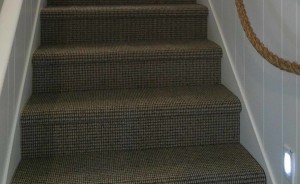Fear of Falling
 I went to a film in a tiny “pocket theater” in back of a bar several weeks ago. As usual, I was late. When I arrived, the room was dark, the film had started, and in a flash of light from the screen I caught the silhouettes of the two girlfriends I was there to meet.
I went to a film in a tiny “pocket theater” in back of a bar several weeks ago. As usual, I was late. When I arrived, the room was dark, the film had started, and in a flash of light from the screen I caught the silhouettes of the two girlfriends I was there to meet.
The theater owner, a man in his late 70s, strode up the aisle to greet me. “My friends are in the middle, right there,” I whispered, pointing to the black hole where I’d seen Linda and Jennifer a moment ago. My eyes had not adjusted to the dark. That’s taking longer and longer these days.
“Okay, I’ll take you,” the man whispered, grabbing my hand. He pulled. I panicked: Were there stairs? Would I trip and fall and hit my head on the edge of a seat and make a big bloody mess and embarrass myself? Were there people sitting on the aisles? Would my heavy handbag smack their faces?
He pulled again. “I can’t see!” I hissed, refusing to move. A patron turned to glare at me. The theater owner whispered, “Okay, slowly, here we go.” I could have been his hundred-year-old mother, frail and frightened of falling and breaking a hip.
The specter of “the fall” has followed me for as long as I remember, and I’m not sure why. Some elementary school friend must have said to me, “Grandma fell. And then she died.”
Why? Why would falling kill a person? I have wondered this until now. Now I get it.
I’ve read articles about how frail our bones become as we get older, and for this reason doctors recommend we take calcium tablets. But isn’t balance a birthright? Why is it so hard to stay standing after middle age? I’ll say one thing right now—there is no way I’m giving up high heels. So not falling is very important to me!
From what I’ve experienced lately, two factors are at work here: light and balance.
First the light: I need lots of it now to find my way across the room, or to follow the path to the outhouse at the campground. I’ve always been a reader, and have stared at a computer screen daily since I bought my first desktop in 1984, so maybe the eyestrain has taken its toll. Aging is certainly a factor, too; the longer we live, the longer it takes for the eye muscles to dilate the pupils and let the light in.
Regardless, part of not falling is slowing down, allowing my eyes to adjust to the dark and tapping my toes in front of me when I see a shadow that could be an object, a threshold, or the first step down a staircase. I can’t stand those automatic lighting systems that detect when a person comes into the room because sudden brightness is blinding for me, and that doesn’t help. But maybe I’ll install running lights in the hallways and the stairs.
As for balance, I am noticing a change. It’s like there’s ice on the ground all the time unless I’m wearing flat shoes. I feel more apt to topple or slide or trip or stumble, and it’s only because I’m getting older. A few years ago, I took the solid ground for granted, striding along on four-inch stilettos without a second thought.
I have read that maintaining a state of equilibrium requires both mental and physical capacities that decline as we age. According to Jonathan Blood Smyth, author of Secrets of Pacing and founder of thephysiotherapysite.co.uk:
“As we age our limb muscles gradually lose their strength and we use less and less of our potential joint movements as we walk. Older people gradually adopt a more restricted gait as they increase the number of shorter steps and decrease the amount of joint movement they employ…. As we age our neural abilities reduce in efficiency and the cerebellar part of the brain, which deals with coordination, can also suffer from the process.”
The good news is, balance and bone density improve with the simplest of activities: walking. Tai chi and yoga help, too, both physically and mentally. And my friend May Yue, author of May Yue’s Tao of Youth: Let Nature Heal You, recommends an exercise that anyone can do for better balance.
May says: “Stand with your feet apart. Close your eyes and lift one foot, balancing for at least one minute. Then lift the other foot and balance for one minute on the other leg.” I’ve tried this and it’s surprisingly difficult, but you can hold onto the back of a chair at first, until you get the hang of it. Lifting a foot just means raising it a few inches off the ground by lifting forward from the thigh or backward from the calf, either way.May says if you do this once a day, working up to a full minute with eyes closed and hands free, you’ll never fall. She says that posture is critical, too: “Stand with your pelvis tilted forward and tighten the gluteus muscles at the back of your buttocks,” she says. “By aligning your posture this way, your feet are grounded and it’s harder to fall. You will have more balance.”
Eyes closed. Butt cheeks clenched. Foot lifted. Got it! This is how I plan to conquer any fears of falling. Plus I’m getting back on the bike: I’m going to see another movie in the pocket theater. But this time I’ll arrive before they turn out the lights.
Anne Nicolai is an American writer and editor living in San Miguel de Allende, Mexico.
